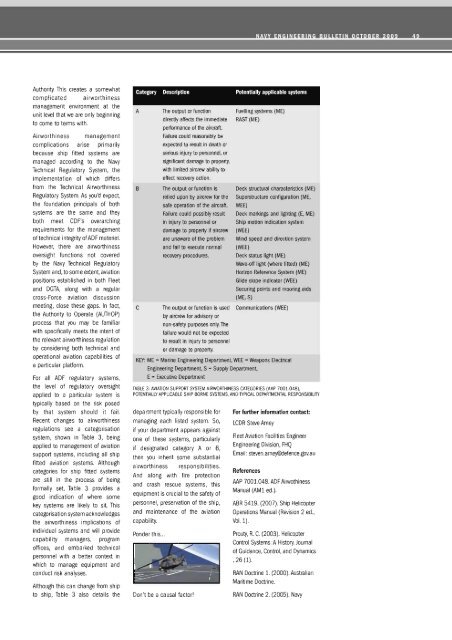ENGINE - Royal Australian Navy
ENGINE - Royal Australian Navy
ENGINE - Royal Australian Navy
You also want an ePaper? Increase the reach of your titles
YUMPU automatically turns print PDFs into web optimized ePapers that Google loves.
Authority. This creates a somewhat<br />
comp licated ai rworthiness<br />
management environment at the<br />
unit level that we are only beginning<br />
to come to terms with.<br />
Airworthiness management<br />
complications arise primarily<br />
because ship fitted systems are<br />
managed according to the <strong>Navy</strong><br />
Technical Regulatory System, the<br />
implementation of which differs<br />
from the Technical Airworth iness<br />
Regulatory System. As you'd expect,<br />
the foundation principals of both<br />
systems are the same and they<br />
both meet CDF's overarching<br />
requirements for the management<br />
of technical integrity of ADF materiel.<br />
However, there are airworthiness<br />
oversight functions not covered<br />
by the <strong>Navy</strong> Technical Regulatory<br />
System and, to some extent, aviation<br />
positions established in both Fleet<br />
and DGTA, along with a regular<br />
cross-Force aviation discussion<br />
meeting, close these gaps. In fact,<br />
the Authority to Operate (AUTH OP)<br />
process that you may be fam iliar<br />
with specifically meets the intent of<br />
the relevant airworthiness regulation<br />
by considering both technical and<br />
operational aviation capabilities of<br />
a particular platform.<br />
For all ADF regulatory systems,<br />
the level of regu latory oversight<br />
applied to a particular system is<br />
typically based on the risk posed<br />
by that system should it fai l.<br />
Recent changes to airworthiness<br />
regulations see a categorisation<br />
system, shown in Table 3, being<br />
applied to management of aviation<br />
support systems, including all ship<br />
fitted aviation systems. Although<br />
categories for ship fitted systems<br />
are still in the process of being<br />
formally set, Table 3 provides a<br />
good indication of where some<br />
key systems are likely to sit This<br />
categorisation system acknowledges<br />
the airworthiness implications of<br />
individual systems and will provide<br />
capability managers, program<br />
offices, and embarked technica l<br />
personnel with a better context in<br />
which to manage equipment and<br />
conduct risk analyses.<br />
Although this can change from ship<br />
to ship, Table 3 also details the<br />
Category Description Potentially applicable systems<br />
A The output or function Fuelling systems (ME)<br />
directly affects the immediate RAST (ME)<br />
performance of the aircraft.<br />
Failure could reasonably be<br />
expected to result in death or<br />
serious injury to personnel, or<br />
significant damage to property,<br />
with limited aircrew ability to<br />
effect recovery action.<br />
B The output or function is Deck structural charactenstics (ME)<br />
relied upon by aircrew for the Superstructure configuration (ME,<br />
safe operation of the aircraft. WEE)<br />
Failure could possibly result<br />
in injury to personnel or<br />
damage to property if aircrew<br />
are unaware of the problem<br />
and fail to execute normal<br />
recovery procedures.<br />
Deck markings and lighting (E, ME)<br />
Ship motion indication system<br />
(WEE)<br />
Wind speed and direction system<br />
(WEE)<br />
Deck status light (ME)<br />
Wave-off light (where fitted) (ME)<br />
Horizon Reference System (ME)<br />
Glide slope indicator (WEE)<br />
Securing points and mooring aids<br />
(ME, S)<br />
C The output or function is used Communications (WEE)<br />
by aircrew for advisory or<br />
non-safety purposes only. The<br />
failure would not be expected<br />
to result in injury to personnel<br />
or damage to property.<br />
KEY: ME - Marine Engineering Department, WEE - Weapons Electrical<br />
Engineering Department, S - Supply Department,<br />
E - Executive Department<br />
TABLE 3: AVIATION SUPPORT SYSTEM AIRWORTHINESS CATEGORIES (AAP 700 1.048),<br />
POTENnALLY APPLICABLE SHIP BORNE SYSTEMS, AND TYPI CAL DEPARTMENTAL RESPONSIBILITY<br />
department typically responsible for<br />
managing each listed system. So,<br />
if your department appears against<br />
one of these systems, particularly<br />
if deSignated category A or B,<br />
then you inherit some substantial<br />
airworthiness responsibilities.<br />
And along with fire protection<br />
and crash rescue systems, this<br />
equipment is crucial to the safety of<br />
personnel, preservation of the ship,<br />
and maintenance of the aviation<br />
capability.<br />
Ponder this ...<br />
Don't be a causal factor!<br />
For further information contact:<br />
LCDR Steve Arney<br />
Reet Aviation Facilities Engineer<br />
Engineering Division, FHQ<br />
Email: steven.amej@defence.gov.au<br />
References<br />
AAP 7001.048. ADF Airwothiness<br />
Manual (AMi ed.).<br />
ABR 5419. (2007). Ship Helicopter<br />
Operations Manual (Revision 2 ed.,<br />
Vol. 1).<br />
Prouty, R. C. (2003). Helicopter<br />
Control Systems: A History. Journal<br />
of Guidance, Control , and Dynamics<br />
, 26 (1).<br />
RAN Doctrne 1. (2000). <strong>Australian</strong><br />
Maritime Doctrne.<br />
RAN Doctrine 2. (2005). <strong>Navy</strong>

















